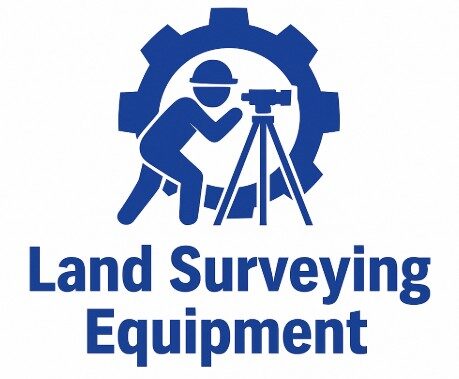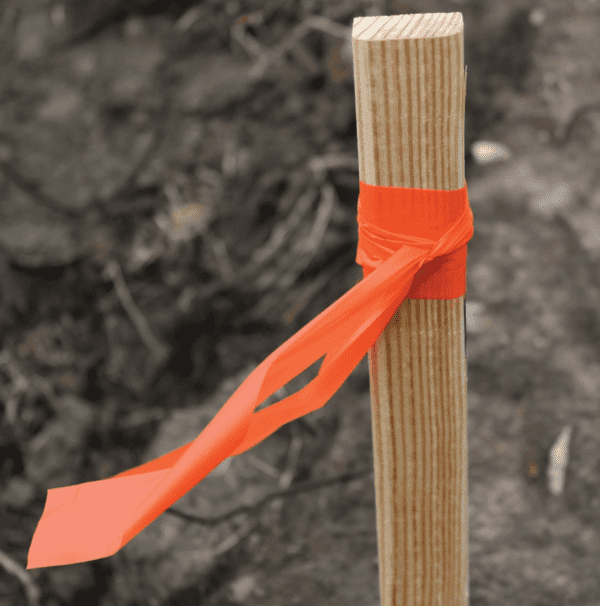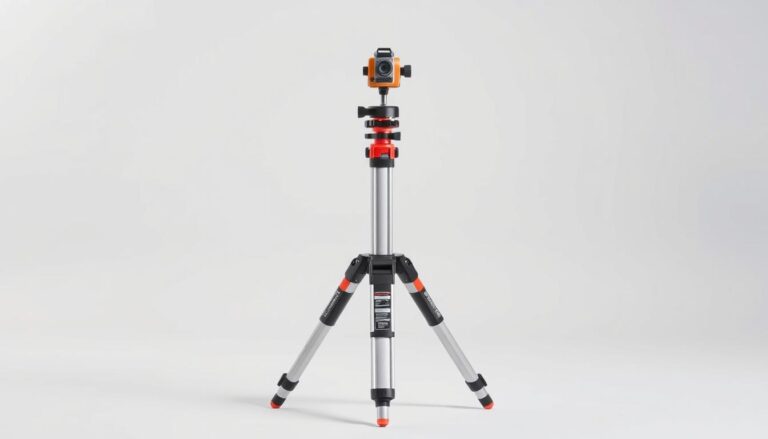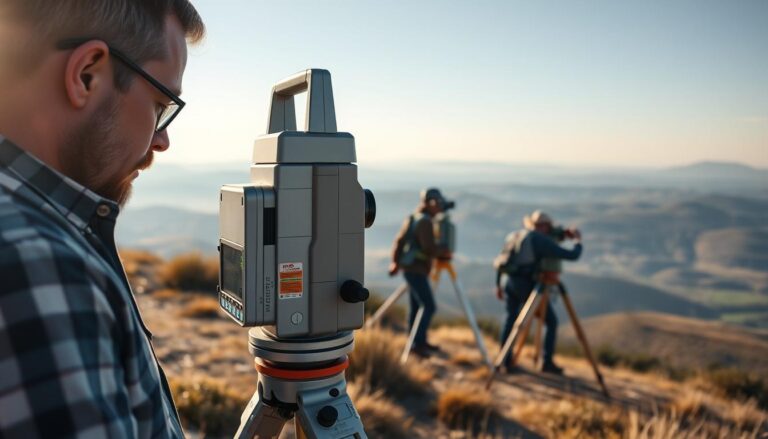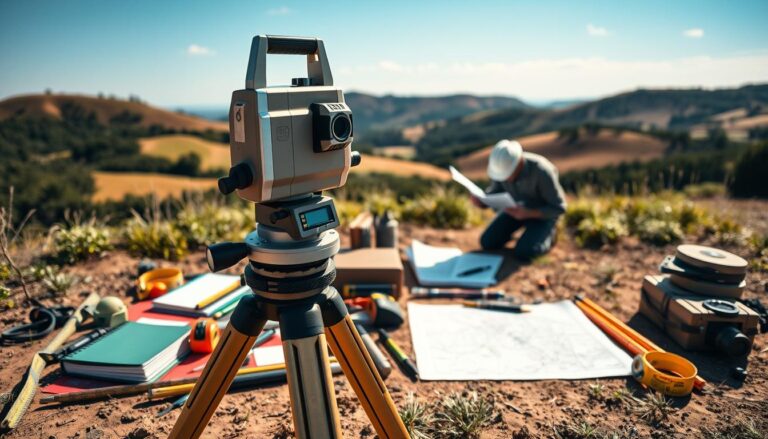Elevate Your Surveying with Top-Notch Total Stations
Setting up your total station right is key to a successful surveying project. You need accuracy and speed to meet deadlines.
Having the right surveying technology is a must, whether you’re experienced or new. Precision measurement tools like total stations help you achieve top accuracy.
By using the latest technology and following best practices, you can improve your surveying skills. This leads to better results for your projects.
Key Takeaways
- Proper setup of total stations is crucial for surveying success.
- Surveying technology enhances accuracy and efficiency.
- Precision measurement tools are essential for high-quality results.
- Best practices ensure successful project completion.
- Latest surveying technology elevates surveying capabilities.
The Evolution of Surveying Technology
Modern surveying has changed a lot, moving from old methods to new digital ones. The need for better precision and speed has led to big changes. This is thanks to new surveying technology, like total stations and digital tools.
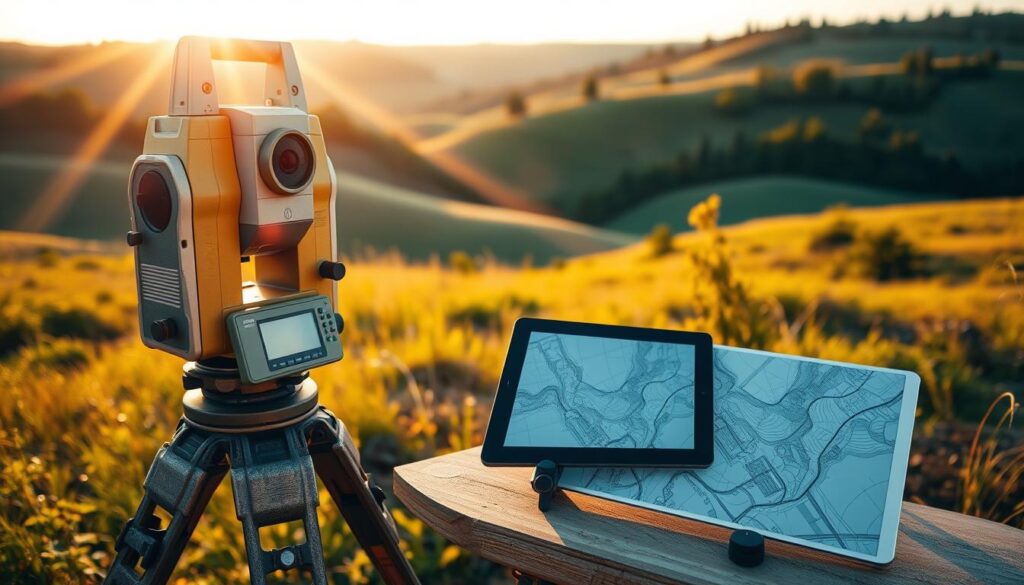
From Traditional Methods to Digital Solutions
Old surveying methods used manual measurements and tape measures. Now, we have more accurate and fast digital solutions. Land survey equipment has gotten better, using GPS and laser scanning for better data.
- Enhanced accuracy and precision
- Increased efficiency in data collection
- Improved analysis capabilities through digital software
The Impact of Precision Instruments on Modern Surveying
The use of surveying instruments like total stations has changed surveying a lot. These tools have made surveys more accurate and the process faster and cheaper.
- Total stations enable the direct upload of coordinates from BIM models, enhancing layout accuracy.
- Digital data collection reduces the likelihood of human error.
- Advanced software facilitates complex analyses and decision-making.
As surveying technology keeps getting better, the future of surveying looks bright. It’s clear that digital advancements will keep surveying at the top of precision and efficiency.
What Makes Total Stations Revolutionary for Surveyors
Total stations are a big deal in surveying. They are precision measurement tools that are key in construction and land development.
These tools combine a theodolite with electronic distance measurement. This makes them very useful construction survey tools. They can measure distances, angles, and heights very accurately. This has changed how surveyors do their jobs.
Core Functionality and Basic Principles
Total stations can measure distances and angles at the same time. They use advanced tech like EDM and optics to do this.
- Measuring distances with high accuracy using EDM technology.
- Calculating angles and heights with precision.
- Recording and storing data for further analysis.
These features help surveyors get detailed data fast. This makes total stations essential in modern surveying.

Advantages Over Conventional Surveying Tools
Total stations have big advantages over old surveying tools. They are more precise and save time and effort.
Precision and Accuracy Benefits
Using total stations means you get much better accuracy. This is very important in projects like construction and building infrastructure.
Time and Labor Efficiency
Total stations make surveying faster and easier. This is a big plus in busy construction projects where time is critical.
By using total stations, surveyors can cut down on mistakes and work faster. Getting accurate results is a major benefit of using total stations.
Types of Total Stations for Different Surveying Needs
Surveyors today have many total stations to choose from. These range from simple manual tools to advanced robotic systems. Each type is designed for specific needs, making work more efficient and accurate.
Manual Total Stations
Manual total stations are the traditional choice. They need manual operation for tasks like pointing and recording data. They are more affordable and good for smaller projects or when simplicity is key.
Key Features:
- Manual operation for precise control
- Cost-effective for smaller projects
- No dependency on advanced technology
Robotic Total Stations
Robotic total stations, like the Leica iCON, are a big step forward in surveying. They work faster and make fewer mistakes. This makes them perfect for big and complex projects.
Benefits include:
- Enhanced speed and productivity
- Reduced need for manual intervention
- Seamless integration with field software
Reflectorless Total Stations
Reflectorless total stations let surveyors measure without a reflector. This makes data collection much faster, especially in tough terrains.
Advantages:
- Fast data collection
- Ability to measure hard-to-reach points
- Increased safety for surveyors
Integrated GPS Total Stations
Integrated GPS total stations mix the precision of total stations with GPS. They offer a strong solution for many surveying tasks.
Key Benefits:
- Enhanced accuracy through GPS integration
- Flexibility in various surveying environments
- Streamlined data collection and processing
| Type of Total Station | Key Features | Applications |
|---|---|---|
| Manual | Manual operation, cost-effective | Small projects, simple tasks |
| Robotic | Automated, high-speed, integrates with software | Large-scale, complex projects |
| Reflectorless | No reflector needed, fast data collection | Challenging terrains, hard-to-reach points |
| Integrated GPS | Combines total station and GPS technology | Varied surveying tasks, enhanced accuracy |
In conclusion, picking the right total station is key for surveying projects. Knowing the different types and their benefits is essential for the best results.
Top 5 Total Stations Dominating the Market in 2023
In 2023, five top total stations are changing surveying. They bring new levels of precision, efficiency, and reliability.
Trimble S-Series: Precision and Reliability
The Trimble S-Series is known for precision and reliability. It uses advanced tech for accurate measurements in tough field conditions.
These stations meet surveyors’ high demands. They offer exceptional angular and distance measurement precision. Trimble’s S-Series shows their dedication to innovation and quality.
Leica Geosystems TS16: Swiss Engineering Excellence
The Leica Geosystems TS16 showcases Swiss engineering excellence. It’s known for its high accuracy and reliability, making it a top choice for surveyors.
The Leica Nova TS60 is the most accurate total station globally. It offers exceptional measurement precision. This precision is key for complex projects.
Topcon GT Series: Speed and Accuracy Combined
The Topcon GT Series combines speed and accuracy for various surveys. They boost productivity and efficiency in the field.
Topcon GT Series total stations are great for many projects. They help surveyors succeed in construction and land development.
Sokkia iX Series: Versatility for Various Applications
The Sokkia iX Series is known for versatility and robust performance. These total stations handle different survey tasks with ease and precision.
Sokkia iX Series total stations have user-friendly interfaces and advanced features. They’re perfect for surveyors needing flexibility and accuracy.
Nikon XS Series: Affordable Quality for Professionals
The Nikon XS Series offers affordable quality without losing performance. These total stations give professionals reliable and accurate measurements.
Nikon XS Series total stations are good for many surveying tasks. They offer quality and affordability, appealing to professionals seeking value.
Essential Features to Look for in High-Performance Total Stations
The success of total stations in surveying technology relies on key features. These features boost their performance and efficiency. It’s important to look at various aspects that affect how well they work in the field.
Measurement Accuracy and Range Capabilities
First, consider the total station’s ability to measure accurately and over long distances. Top-notch total stations have precision measurement tools. They can measure distances and angles with high accuracy, even over long ranges. This accuracy is crucial for reliable data.
| Feature | Description | Importance Level |
|---|---|---|
| Measurement Accuracy | Ability to accurately measure distances and angles | High |
| Range Capabilities | Maximum distance the total station can measure | High |
| Battery Life | Duration the total station can operate on a single charge | Medium |
Battery Life and Field Durability
Battery life and durability are also key. A total station that lasts long and is tough can handle fieldwork well. It cuts down on downtime and boosts productivity. Experts in land survey equipment stress the need for durability in tough environments.
User Interface and Operational Simplicity
The ease of use and interface of a total station matter a lot. A simple interface helps surveyors work efficiently. It shortens the learning time and lowers the chance of mistakes. Today’s total stations often have easy-to-use interfaces that make complex tasks simpler.
- Clear and intuitive menu navigation
- Customizable settings for specific tasks
- High-resolution display for clear visibility
Connectivity and Data Transfer Options
Lastly, connectivity and data transfer are crucial. Being able to easily share data with other surveying technology and software speeds up work. Look for total stations with options like Bluetooth, USB, or Wi-Fi for easy data transfer.
In summary, when picking high-performance total stations, focus on accuracy, battery life, user interface, and connectivity. By choosing wisely, professionals can find the best precision measurement tools for their needs. This improves the quality and speed of their surveying work.
Industry-Specific Applications of Total Stations
Total stations have changed many industries with their precision and speed. They are more than tools; they make things accurate and efficient in different fields.
Construction and Infrastructure Development
In construction and infrastructure, total stations are key. They help with building layout and alignment, making sure buildings are built right. This is important to avoid expensive mistakes and meet deadlines.
Building Layout and Alignment
Total stations help place buildings exactly right by finding key points. This is very important for big projects where small mistakes can cause big problems.
Road and Bridge Construction
In road and bridge work, total stations are used for aligning and grading. They make sure the roads and bridges are built right, making them safer and stronger.
| Application | Benefits |
|---|---|
| Building Layout | Ensures accurate positioning, reducing rework |
| Road Construction | Facilitates precise grading and alignment |
| Bridge Construction | Enhances structural integrity through precise measurements |
Land Development and Property Surveys
Total stations are also crucial in land development and property surveys. They help set property lines, check land shape, and plan projects. Their accuracy is key for legal and regulatory needs.
Mining Operations and Volume Calculations
In mining, total stations are used for volume calculations and tracking excavation. They help mining keep track of changes and measure how much material is taken out.
The use of total stations in these fields shows their wide range and big impact on work efficiency and accuracy.
How to Select the Right Total Station for Your Specific Needs
Choosing the right total station is crucial for efficient surveying. Your main goals are to work accurately and quickly. Total stations offer many benefits to help you achieve these goals.
Understanding your project’s needs is key to making a good choice. Different projects need different features in a total station. For example, construction might need high accuracy, while mining might require advanced distance measurement.
Assessing Your Project Requirements
Start by evaluating your project’s needs. Think about the project type, terrain, and accuracy level needed. For example, land survey equipment in dense forests might need reflectorless measurement for efficient surveys.
- Determine the scale of your project and the number of measurements needed.
- Consider the environmental conditions: weather, terrain, and potential obstacles.
- Evaluate the level of precision required for your measurements.
Budget Considerations and ROI Analysis
Cost is a big factor in choosing a total station. While cheaper options might seem appealing, think about the long-term savings. Advanced surveying instruments might cost more but save money in the long run by increasing efficiency and reducing labor costs.
When analyzing ROI, consider:
- The cost of the total station and any additional accessories or software.
- The potential increase in productivity and efficiency.
- The reduction in labor costs due to automation and streamlined processes.
Training and Support Requirements
Lastly, think about the training and support needed for the total station. A user-friendly interface and good training can help your team learn quickly. Look for manufacturers that offer strong support, including tutorials, customer service, and regular software updates.
By carefully assessing your project needs, considering budget and ROI, and evaluating training and support, you can find a total station that meets your needs. This will improve your surveying capabilities.
Maximizing Efficiency with Total Station Accessories
Efficiency in surveying isn’t just about the total station. It’s also about the accessories that go with it. The right ones can greatly improve accuracy, speed, and productivity.
Total station accessories make these devices more versatile and easy to use. Essential prisms and reflectors are key for accurate measurements.
Essential Prisms and Reflectors
Prisms and reflectors help by reflecting the laser beam back to the total station. High-quality prisms and reflectors ensure accurate measurements, even over long distances.
The right prism or reflector depends on the survey’s needs. For example, in tough environments, reflectors with enhanced signal return are very useful.
Data Collectors and Field Software
Data collectors and field software are crucial for modern surveying. They connect the surveyor to the total station. They make the surveying process smoother.
Data collectors help surveyors record and manage data efficiently. With field software, they become a powerful tool for data analysis.
Tripods, Poles, and Mounting Systems
The stability and position of the total station are key for accurate measurements. Tripods, poles, and mounting systems ensure the total station is securely set up.
A strong tripod keeps the total station steady and level. Poles and mounting systems allow for flexible positioning, especially in tough terrain.
Choosing the right total station accessories boosts efficiency and productivity. They improve measurement accuracy, streamline data collection, and ensure stability. The right accessories truly make a difference.
Maintenance and Care for Longevity of Your Total Station
Keeping your total station in top shape is key to its accuracy and longevity. These instruments are vital in surveying and can be affected by many things. This includes the environment and how much you use it.
Regular Calibration Procedures
Calibration is vital for accurate measurements. Over time, wear and environmental changes can affect your total station. Regular checks are crucial to keep it precise.
- Do calibration checks as often as the maker suggests.
- Use the tools and software given by the maker.
- Keep records of your calibration results.
Storage and Transportation Best Practices
Storing and moving your total station right is important. Always keep it in a protective case when not using it. Make sure it’s secure when you move it to avoid damage.
- Clean the total station before storing to stop dust and dirt buildup.
- Don’t let it get too hot or wet.
- Use the best accessories for storage and moving.
Troubleshooting Common Issues in the Field
Even with good care, problems can happen in the field. Knowing how to fix common issues quickly saves time and keeps things running smoothly.
- Make sure the battery is full and all connections are tight.
- Look in the user manual or contact the maker for help with specific problems.
- Keep your total station’s software up to date.
By following these tips, you can make your total station last longer. It will keep giving you accurate and reliable results.
Future Innovations in Total Station Technology
The surveying world is on the verge of a big change with new total station tech. As projects get more complex, the need for better precision and fewer mistakes has pushed for new survey tools, like total stations.
One big step is adding AI and machine learning to total stations. This lets them automatically handle data, spot patterns, and predict outcomes. For example, AI total stations can now find and measure tricky site features on their own, cutting down on manual work.
AI and Machine Learning Integration
Adding AI and machine learning to total stations is changing how surveyors do their jobs. These techs help with quick data analysis and decisions, making surveys more accurate and faster. Plus, AI total stations get better with time, adapting to new situations and improving their work.
| Feature | Traditional Total Stations | AI-Integrated Total Stations |
|---|---|---|
| Data Processing | Manual data entry and processing | Automated data processing and analysis |
| Accuracy | Dependent on operator skill | Enhanced accuracy through AI-driven measurements |
| Efficiency | Limited by manual data handling | Improved efficiency through automated workflows |
Enhanced Connectivity and Cloud-Based Solutions
Another key change is the better connectivity of total stations. This lets them work smoothly with cloud-based systems. Surveyors can now share and access data instantly, making teamwork easier and cutting down on data loss risks. Cloud tech also means total stations can be controlled and monitored from anywhere, making them even more useful.
With gps survey equipment and land survey equipment joining forces, total stations are becoming a key part of a bigger surveying system. As total station tech keeps getting better, we’ll see even more cool uses in surveying.
The future of total station tech looks very promising. With ongoing improvements, the surveying field is set to see better efficiency, accuracy, and productivity. Surveyors and builders have a lot to look forward to.
Conclusion
Total stations are key in the surveying world. They help make work more accurate, efficient, and cost-effective. Knowing about different types and features is important for surveyors.
Using robotic total stations can greatly benefit your work. Brands like Trimble, Leica Geosystems, and Topcon offer top-notch devices. Choosing the right one can make your work smoother, cheaper, and better.
Total stations will keep being important as the industry grows. Keeping up with new technology is crucial. This way, surveyors can excel in their projects.
